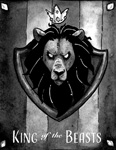Story by G.W. Thomas
Illustration by John Waltrip
I miss the Pulps. Not for the garish covers featuring aliens molesting sweet-young space maidens. Not for the variety that gave us the brash adventure of Luke Short to the dirty streets of Dashiell Hammett to the terror tales of H. P. Lovecraft. Not even for the fact that stories had beginnings, middles, and ends. Not for any of these.
I miss the pace. Modern writers have nothing on the Pulps for opening a story in a hurry, a blinding punch or slap of color. Once delivered, they just kept on writing to the searing end. That’s what I miss. Reading by the seat of your pants.
And it all begins with that opening sentence. Whether it throws you into a story or merely teases you to the next sentence, it’s there to draw you in. Let’s take a look at some of the masters of the hook.
Adventure magazines were varied and most focused on exciting tales in far away locals. Some were set on the seas, others in jungles, others all over the world. One of the best adventure writers was Robert E. Howard. No matter if it was a heroic fantasy or a straight adventure tale, he always started with a bang.
“It was the stealthy clink of steel on stone that wakened Gordon.” (“Lost Valley of Iskander”) With these words, we are immediately standing beside Gordon as danger approaches. What follows is a desperate fight in which Gordon holds back the hand bearing a knife and strangles his opponent with his other hand. We pull back to see a cold, wind-swept Afghan hillside where Gordon, known as El Borak, was sleeping.
“White hunter Dane was dead set against it; and, it was Dane’s business to know Africa.” That’s from Gordon MacCreigh’s “Zimwi Crater” from Argosy Weekly, August 11, 1934. Don’t you want to know what this obvious professional was against? No doubt it was exciting as only bad ideas can be. MacCreigh was one of the lords of the jungle, having run away to the tropics when he mistakenly thought he had killed a man. Here is a guy who knows about poor choices.
Westerns were a specific type of adventure magazine, and probably the most popular of all Pulp genres. Tales of gunslingers and cowboys usually started with setting the scene.
“The posse straggled across the drainage ditch from the water-hole, the mustang hoofs kicking up droplets of wet sand, and rode toward the small, unpainted shack on the bank of the watering spot.” Jackson Cole (probably Tom Curry writing under the house name) sets the scene quickly with specific detail.
“Riding into Splitrock, Wayne Morgan’s senses – the keenly whetted instincts of a man long hunted by men – detected the pressure of suspense which gripped the cowtown, built within the Winchester range of the Mexican border.” Walker A. Tompkins crams a lot into that sentence, setting, expectation and a description of the hero. (Masked Rider Western, November 1950.)
Another adventure type Pulp was the war magazines. This from Battle Birds, February 1942: “Death struck at dusk above the ghostly moors of England and ushered two Leopard Squadron pilots into the unknown vastness of the Gloryland.” Robert Fleming has your attention immediately.
“Chill fingers of icy fear needled deep into Red Ballew’s being as he became conscious of five Mitsubishis blasting down through the hell-racked sky.” James O. Goodwin sets the action with a quick jolt. No doubt by the end of it, the American pilot will have defeated his enemies with great daring.
The Mystery magazines varied, of course. There were traditional English-style detectives in the early days. But one of America’s biggest contributions to the genre was the hard-boiled school of Noir, where Sunday tea was replaced by illegal booze and dark alleys.
“Late Friday afternoon, or rather early Friday evening, when Al Murray the head cashier at the Bon Ton Department Store completed counting the week’s cash and locked the vault on the proceeds of the Bon Ton’s mid-August sale, he had not the remotest idea of returning Saturday night, packing one hundred and eighty thousand dollars into a suitcase and – leaving his wife and Los Angeles behind him—fleeing with Grace Ferris to Pandang, Singapore, and Bangkok, via Mexico City, San Salvador, and Lima.
Wow! Don’t you want to know why all that happened? Keep reading. Day Keene was a master of Noir writing. With that single paragraph, he preloads the reader for a tale of deceit, crime and in this case, the supernatural. This didn’t appear in his usual pages at Detective Tales but in Weird Tales!
“The thing, whatever it was – and no one was ever sure afterwards whether it was a dream or a fit or what – happened at that peculiar hour before dawn when human vitality is at its lowest ebb.” Thus, master suspense writer, Cornell Woolrich begins “I’m Dangerous Tonight” (All-American Fiction, November 1937) Like Keene, Woolrich is priming the pump, but does it in a way that intrigues but tells so little.
The women weren’t left out of the Pulp business. They had the Romance Pulps. Some of these even specialized like Ranch Romance.
“Slowly, half reluctant, Jeb Stone walked down the worn gray boardwalk toward the little house where Cassie Stephens lived.” opens: “Law for the Greenhorn” by Leola Lehman in Ranch Romance, November 1953.
“Marcia Milner stood expectantly at the corral gate watching the narrow ribbon of road that wound back across the prairie.” That’s Bess Rogers’ “Heartbreak Crossing” in Rangeland Love Stories, December 1952.
In both cases, the writer, who were actual women who wrote, not men writing under house names, has set up a moment of expectation. Jeb Stone is about to do something that will affect his love life forever, while Marcia Milner waits for something to happen that will do the same. If you want to find out what, keep reading…
Shudder Pulps are kind of hard to explain today. They were the most “purple” of the Pulps, designed to set up highly implausible situations that look supernatural or horrific at first. Nothing like them really exists today. The closest we have is either splatterpunk horror or serial killer fiction. The Shudder Pulps were also known for their Grand Guignol titles, like “Black Pool for Hell Maidens” or “Blood for the Vampire Dead”.
Hal K. Wells begins “Salmon for Satan” (Dime Detective, February 1945) with: “Beyond the glow of the streetlights along Barton Street’s unlovely length, the night was dark with the blackness of the first hour after midnight.” This is pretty typical of a Shudder Pulp. They all seem to happen at night or in remote places or both.
“As Edith Horne slid furtively through the rank underbrush of Uriah Scantell’s abandoned orchard, the old sense of guilt at being on forbidden ground quickened her pulse with a familiar mingling of excitement and quivering apprehension.” That’s from Arthur Leo Zagat’s “Death Breaks Quarantine” from Dime Mystery, February 1937. Deftly Zagat sets the scene, the mood, and action all in the first sentence. Zagat was one of the kings of shudder.
The Shudder Pulps were always couched in the real. The monster turns out to be paper mache, the werewolf, a madman. True horror magazines were different. They featured stories that had actual supernatural things in them. The best of these was Weird Tales, edited by Farnsworth Wright.
“There was thunder in the air on the night I went to the deserted mansion atop Tempest Mountain to find the lurking fear.” H. P Lovecraft opens this creepy classic with simple sounding details. As you read the story you find out why that thunder is significant along with the morbid secrets of that mansion and mountain. (Weird Tales, June 1928)
“I, Satampra Zeiros of Uzuldaroum, shall write with my left hand, since I have no longer any other, the tale of everything that befell Tirouv Ompallios and myself in the shrine of Tsathoggua, which lies neglected by the worship of man in the jungle-taken suburbs of Commorium, that long-deserted capital of Hyperborean rulers.” (Weird Tales, November 1931) The verbal magic of the poet Clark Ashton Smith is a lesson in painting with words. In this opening sentence (not paragraph!) he gives us the players, the setting and even the dire consequences.
Science Fiction began as a wordy collection of gadgets and ideas under Hugo Gernsback.
But after a few decades, the action start found Scientifiction too. “There is a sweet little horror story that is only two sentences long: “The last man on Earth sat alone in a room. There was a knock on the door…” With that setup, Science Fiction and Mystery writer, Fredric Brown sets up a post-apocalyptic tale that opens with a surprise. And ends with one too.
“The place stank.” With three words, John W. Campbell begins his classic “Who Goes There?” (Astounding, August 1938) We all know this story better as The Thing from the movies by Howard Hawks and John Carpenter. The short phrase throws us right into the experience of being in an Antarctic station, living close quarters with others. It also starts the story with a downbeat note, a promise that badness is going to commence.
Whether a Pulp writer started long or short, the intention was always the same. Get the reader in the middle of things as fast as possible. Dimes were hard to come by in the depths of the Great Depression. A magazine that provided quick, pulse-pounding entertainment was purchased again and again.
You can’t buy a magazine for so little anymore, but the great fast-paced fiction is still with us, both in the original stories and in new ones written by today’s writers who crave that same exciting experience. Long live the Pulps!
— ♦♦♦ —
END
Next Week:
 King of the Beasts. By Mike Murphy, Art by Lee Dawn
King of the Beasts. By Mike Murphy, Art by Lee Dawn
John Baxter was a self-made man. He had come to Africa and opened a hunting preserve. He had a good relationship with the locals. Unfortunately, his fortune wouldn’t last and he would discover who REALLY is king of the beasts.
